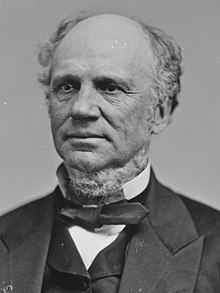Seymour - The Man Who Met The Hour
This is my first ever attempt at making a TL about American history, so any advices and constructive criticism are welcome.

Horatio Seymour (Democratic, 1861-1865)

Horatio Seymour (Democratic, 1861-1865)
Stephen A. Douglas had experienced poor health throughout his life, which greatly deteriorated after he narrowly lost the Illinois Senate seat to Republican Abraham Lincoln. He eventually fell into his eternal slumber on a cold November night in 1859. [1] The Northern Democrats were in search of a new leader, and they found one in Horatio Seymour, the former Governor of New York. Seymour himself was a delicate balance between not being a full-blown doughface like the incumbent President James Buchanan, and moderate enough on slavery not to alienate the party's southern wing like the late Douglas. Except for the firebrand Fire-Eaters, the Democrats needed to have a united party, for a Republican victory, so they thought, would only lead to chaos and even disunion.
With the unpopular Buchanan declining to run for a second term, Seymour became the frontrunner candidate for the Democratic presidential nomination in 1860. [2] Seymour's most serious challengers for the nomination was Vice-President John C. Breckinridge and former Treasury Secretary James Guthrie, both having served under Buchanan. After Seymour had effortlessly won his nomination, former Governor Benjamin Fitzpatrick from Alabama was chosen as the Vice-Presidential candidate for the sake of geographical balance between north and south. Pro-secessionist southerners were kept in line with bribes. Meanwhile, William H. Seward won the Republican nomination as many have expected, with Senator Abraham Lincoln from Illinois being his running mate. As both major presidential contenders were from New York, the Empire State was set to be a true electoral battlefield.On the campaign trail, Seymour tried his best to distance himself from the Buchanan administration. He repeatedly warned that another four years of Democratic presidency was the only thing that stood between the Union and its dissolution. While Seward's abolitionism was easy target for Democratic attacks, the Republicans associated Seymour to the looming slave power that threatens to subvert the Union under its rule. All odds were stacked against Seymour until a last-minute announcement that he had won his home state of New York with a razor-thin margin, securing him a majority in the electoral college. Later historians would attribute this extremely narrow victory to New York's powerful Democratic political machine. Horatio Seymour would be inaugurated as the 16th President of the United States on March 4, 1861.
Horatio Seymour/Benjamin Fitzpatrick (Democratic) - 165 EV
William H. Seward/Abraham Lincoln (Republican) - 138 EV
John J. Crittenden/Sam Houston (Constitutional Union) - 0 EV
Cabinet of Horatio Seymour
Vice-President: Benjamin Fitzpatrick
Secretary of State: John C. Breckinridge
Secretary of the Treasury: Joseph Holt
Secretary of War: Daniel S. Dickinson
Secretary of the Navy: Isaac Toucey
Secretary of the Interior: Jefferson Davis
Attorney General: Benjamin Butler
Postmaster General: Joseph Lane
On December 21, 1861, Spanish troops landed in Veracruz and occupied the city in a matter of two days. British and Spanish troops would arrive two weeks later. After having issued a manifesto that the intervention was not meant to instigate a change of regime in Mexico, negotiations began between the three European powers and the Mexican government. However, talks began to break down after France had made clear that it wished to overthrow the current Mexican government and replace it with a pro-French monarchy headed by the Austrian archduke Ferdinand Maximillian Josef Maria. Britain and Spain withdrew from Mexico as a result, leaving the French as the main foreign player in Mexico. [3] Once the United States became aware of the situation, they dispatched a diplomatic letter through Minister to France Charles J. Faulkner addressed to the French government. This message insisted that France withdraw its troops from Mexico immediately, emphasizing that any military action would be met with a prompt response from America. Napoleon III may have been hesitant about American intervention and therefore backed down at his intention of regime change in Mexico. However, this was on the condition that the Juárez administration gradually pay its debts at a lower interest rate over time. Although financially unstable, the Mexican government reluctantly agreed to these terms, which came at a significant cost in terms of both money and national pride. Still, it was a better alternative to having your country overrun by American or French troops.
Other than the brief hype surrounding the Mexican fiasco, Seymour's presidency was a rather quiet one. Nevertheless, news reports of violent confrontations between American troops and the Apache on the Western frontiers were regular occurrence [4]. During the 1863 midterms, the Republicans secured a significant majority in both houses of Congress, rendering Seymour a lame-duck incumbent. He was concerned that he might be remembered in history like Pierce and Buchanan, who were unable to resolve the disputes that was splitting America apart. Northern Democrats began criticizing Seymour for supposedly showing too much deference to Southern interests, while Southern Democrats distrusted him due to his northern roots and grew increasingly frustrated by his inaction - a mood shared by most of the country. However, Seymour would have a chance to prove his worth as the nation's Commander-in-Chief, when he was faced with the fallout of the inevitable Republican victory in 1864...
[1] This is the POD.
[2] Seymour's OTL hesitance to run for national office would be butterflied away.
[3] Same as OTL.
[4] Referring to the Apache Wars, which became bloodier than IOTL due to the US not being embroiled in civil war.
Last edited: